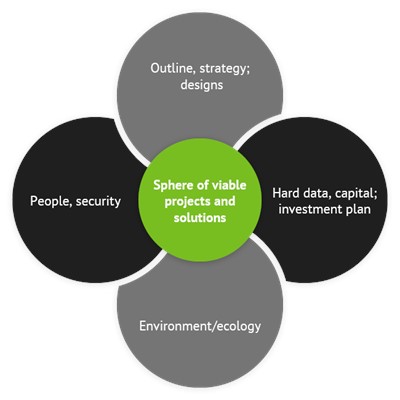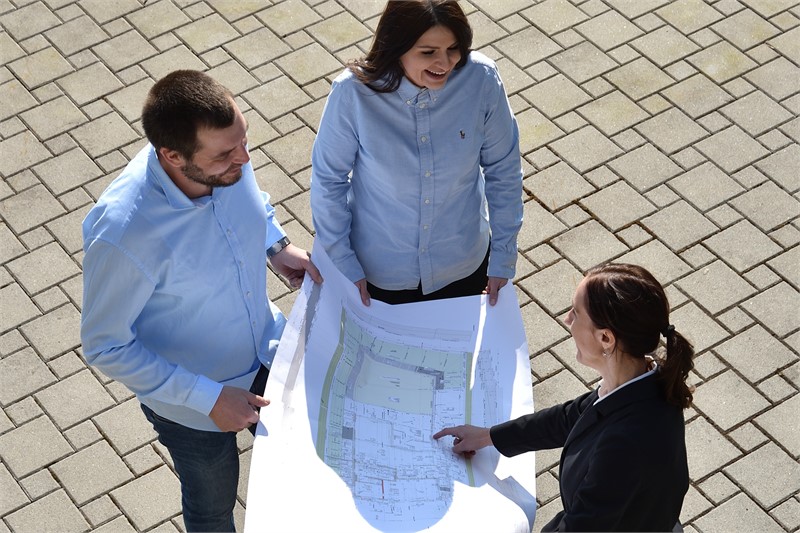Planning phase
During the planning phase, building projects may be optimised for the best result and help in the avoidance of defects.

An extensive planning phase is the beginning and end of any successful building project
The planning phase offers many levers to optimise the future project and the soft issues point in the right direction for an optimal result. Possible solutions are followed up, project designs in relation to optimal land usage, market-conforming planning and economic viability are compared with the aesthetic requirements and official obligations. Goal-setting is continuously compared with the actual position. The construction audit keeps a watchful eye on this.
Building works are in most cases one-offs, apart from which, the planning is under considerable pressure to succeed at the first go to produce a workable building project. The planning work must thereby fulfil the demands of the constructor and mostly also guarantee a high degree of spatial flexibility.
Correspondingly the planning of a building project rests upon varying realities (actual position) and also upon technical pressures (political decisions). Within these framework requirements, to which belong, for example, hard data and capital, people and safety, environment and ecology, can be found the realm of realistic projects and solutions.
With the aid of user requirements and comparison with the actual position, concrete designs may be developed.
The different solutions and variations are compared and studied in the next step. During the assessment of all variations, it is always kept in mind to proceed from the same basis. The evaluation of the must and can demands eases the taking of any decision regarding which variations should be worked upon in the pre-project.
Furthermore the most economic solution is striven for, as in investment decisions, large capital sums are tied up for the long-term and may mostly only be slightly revised on the grounds of their long duration. Therefore the economic calculation is of the greatest significance to the process of reaching a decision.
It is important that the economic calculation contains details about:
- The calculated subsequent costs, such as write-offs and interest.
- The costs of technical and commercial upkeep.
- Possible subsequent costs, such as demolition works with a time-limited usage period.
The organisation of the project then follows, with the following goals to meet:
- coordination of the service, deadline and cost-oriented planning.
- project planning.
- execution.
- start-up and completion of the project.
The structure of the project organisation may be split into four levels:
- the constructor.
- the planner.
- the contractor in charge.
- the user (may also be the same as the constructor).
The constructor awaits the speedy completion of the contract and undertakes to pay fees for the services provided in conformity with the contract. The planners obligate themselves in the context of their respective service and fee structure to the fiduciary execution of their planning tasks. The principles for this are in SIA Standard 102 ff. So that the collaboration between the constructor and the planner functions successfully, it is important with larger and more significant projects, for their own object-specific project handbook to be produced.
The pre-project is worked upon with variants. The selection of the best variants then forms the basis of the investment decision. After the decision about the best variants comes submission and the contract with the planner. In this process, a clear and precise service description for all involved is striven for.
On the basis of the pre-project, in a further step, the building project is unambiguously described. For this, construction project plans, project and building description, as well as detailed cost estimates, are used for the binding basis of the granting of credit and building implementation. The costs estimates must also be made at the planning phase, as quite often the amount of the forecast costs is the decisive factor for the completion of a project or the start time for the construction. Then follow the cost estimates, which will also be needed for the opening of the construction auditing and the supervision of costs over the entire construction period.
All buildings and units, subject to the cantonal building authority, require planning permission. The following works generally fall under this:
- the creation, a substantial change or the demolition of buildings, parts of buildings or units.
- movables and provisional arrangements.
- the creation or change of storage and material collection depots.
- significant changes to terrain.
According to the constructor and sector of the building project, the confederation, cantons and districts, as well as organisations and private entities may provide services. These possibilities are to be established before the granting of credit and in certain cases to be clarified and put in writing.
According to the building project (maintenance/new build) and the constructor, the relevant competencies for the project’s permissions and granting of credit may differ enormously. The supervisory officials must be certain, however, in every case, that all relevant bodies have approved the project and creditworthiness.




